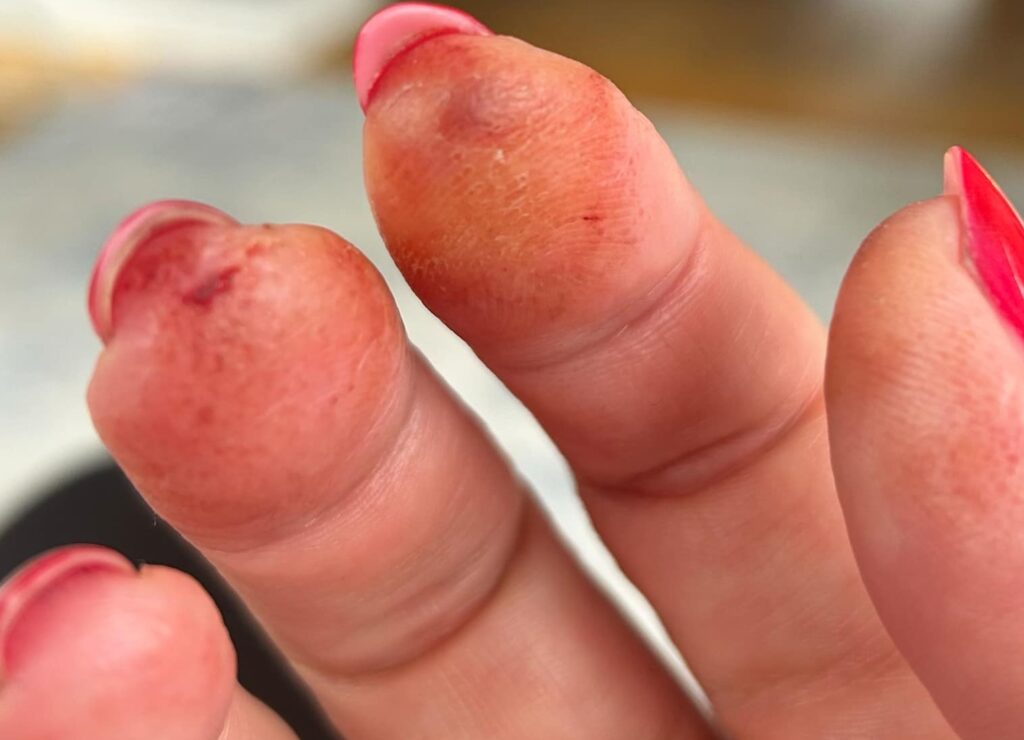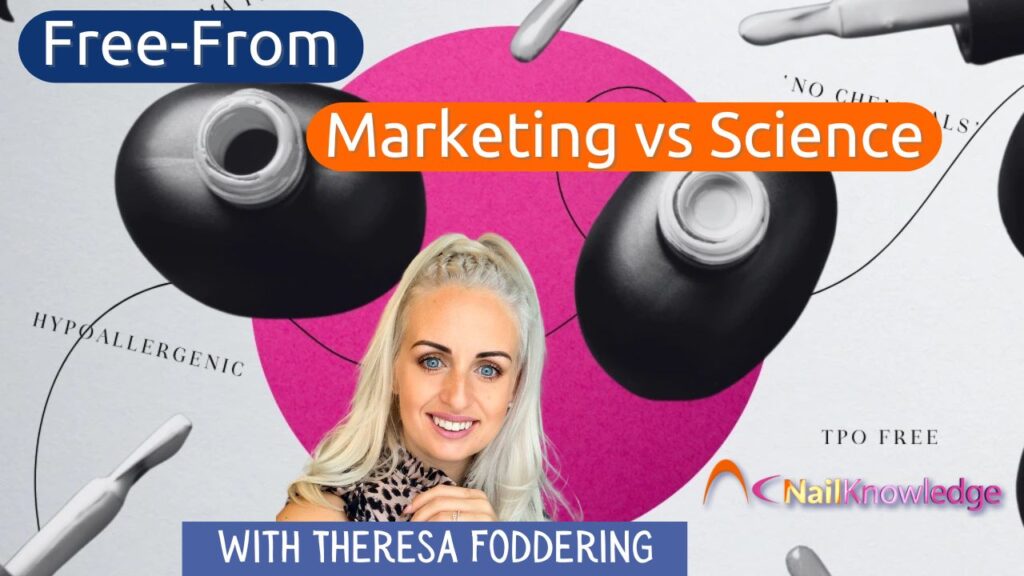Không có Tiếp thị so với Khoa học: Khám phá An toàn Sản phẩm Làm móng
As someone deeply embedded in the professional nail and products industry, I’ve seen firsthand how “free-from” claims influence buying decisions, often without a clear understanding of what they actually mean. In this blog, I want to break down the reality of these claims, the science behind allergens, and why critical thinking is beneficial and transparent when evaluating these marketing trends.
Understanding ‘Free-From’ Claims in the Nail Industry
The idea behind “free from” branding is simple: by excluding certain ingredients that have been deemed harmful or allergenic, companies suggest their products are safer or healthier. Common examples include:
- X-Miễn phí nail polishes, which claim to exclude formaldehyde, dibutyl phthalate, toluene, and other supposedly harmful chemicals.
- Không có HEMA gels marketed as a safer alternative for those prone to allergies.
- Không gây dị ứng các sản phẩm
Nhưng câu hỏi thực sự là: Liệu những thành phần này có thực sự là mối quan tâm của hầu hết người dùng hay đây chỉ là chiêu tiếp thị thông minh?
And let’s not overlook the pressure applied in reverse upon companies to join “free from” formulating and marketing claims to ‘give the people what they want’. It’s a double-edged sword and no one seems to be winning.
Khoa học về chất gây dị ứng: Mọi thứ đều có khả năng gây dị ứng
One of the biggest misconceptions in “free from” marketing is the assumption that the absence of certain ingredients makes a product safer. The truth is that every substance has the potential to cause an allergic reaction.
Ví dụ:
- Lavender oil – A natural ingredient often used in “natural” beauty, but also a known skin allergen.
- Hạt – Completely natural but can be deadly to those with severe allergies.
- Nước – Even water can cause irritant contact dermatitis (ICD) with overexposure.
Yet, we don’t see brands marketing their gels as “free from lavender or nuts,” even though they are just as capable of causing allergic reactions as the ingredients being demonized. This selective marketing plays on fear rather than fact.
Acrylates có ở khắp mọi nơi: Sản phẩm gia dụng và tiếp xúc hàng ngày
Acrylates, particularly those being villainized in nail products, are not unique to the nail industry. Many of these chemicals are found in sản phẩm gia dụng và công nghiệp hàng ngàynhưng không ai vội vàng xóa chúng khỏi những ứng dụng đó.
Ví dụ:
- Ethyleneglycol Dimethacrylate (EGDMA) – Used in plastic bottles for soft drinks, dental materials, printing inks, automobile antifreeze, and engine-cooling liquids.
- Metyl Methacrylat (MMA) – Used in medical prosthetics, dental work, and industrial applications, yet banned in liquid monomer form in some countries for nails due to misuse, not because of toxicity when used correctly.
- Hydroxypropyl Methacrylate (HPMA) – Found in medical-grade adhesives, contact lenses, and of course, nail coatings.
- Tetrahydrofurfuryl Methacrylate (THFMA) – Used in dental materials, artificial nails, and 3D printing, yet has been flagged for its potential allergenic effects.
- Propylene Glycol Monomethacrylate (PGMA) – Found in adhesives, cosmetics, and medical devices, but rarely discussed despite being a known allergen.
- Trimethylolpropan Triacrylat (TMPTA) – A multifunctional acrylate monomer used in UV-curable coatings, adhesives, and inks, but like other acrylates, has the potential to cause skin sensitization and allergic reactions in some individuals.
- Benzyl Methacrylat – Used in artificial nail products, dental materials, and medical devices. It contributes to the durability of polymer formulations but, like other methacrylates, has the potential to cause allergic reactions in sensitive individuals.
Điều này đặt ra một câu hỏi quan trọng: Nếu những hóa chất này được sử dụng an toàn trong các ngành công nghiệp khác mà không gây ra sự hoảng loạn lớn, tại sao ngành công nghiệp làm móng lại phản ứng mạnh mẽ với mọi xu hướng thành phần?

Chất gây kích ứng so với chất gây dị ứng: Biết sự khác biệt để đảm bảo an toàn cho thợ làm móng
Một điểm quan trọng khác thường bị bỏ qua trong các cuộc thảo luận này là sự khác biệt giữa chất gây dị ứng và chất gây kích ứng. Không phải tất cả các thành phần có vẻ đáng lo ngại đều là chất gây dị ứng; một số chỉ đơn giản là chất gây kích ứng khi sử dụng không đúng cách hoặc ở nồng độ cao.
Ví dụ:
- Etyl axetat – A common solvent in nail polish and removers, classified as an irritant rather than an allergen.
- Aceton – A well-known, widely used solvent in nail products that can cause skin and respiratory irritation with overexposure but is not classified as an allergen.
- Methacrylic Acid (MAA) – A key organic component used to maximize adhesion between the nail and artificial coating. It is highly reactive and can cause skin and respiratory irritation upon direct exposure. Not considered a strong allergen but certainly a strong irritant.
Vậy chúng ta đang vạch ra ranh giới ở đâu? Chúng ta có chọn sống trong sợ hãi, loại bỏ mọi chất gây dị ứng tiềm ẩn bất kể bối cảnh nào không? Hay chúng ta chỉ đang chờ đợi cơn hoảng loạn thành phần tiếp theo được chỉ bảo?
Tranh cãi về HEMA: Sự hoán đổi thành phần hay tiến bộ thực sự?
One of the biggest ingredient shifts we’ve seen in recent years is the demonization of HEMA (Hydroxyethyl Methacrylate). Initially flagged due to allergic reactions in some users, the backlash against HEMA led to the rise of HEMA-free alternatives using IBOA (Isobornyl Acrylate) and HPMA (Hydroxypropyl Methacrylate). But now, we’re seeing the same cycle—concerns beginning to emerge over these replacement ingredients….
Điều này nêu ra một vấn đề quan trọng: Liệu chúng ta có thực sự làm cho sản phẩm an toàn hơn hay chỉ đang chơi trò hoán đổi thành phần bất tận?
The truth is any acrylate or methacrylate-based system carries a potential risk of allergy. The real solution isn’t just removing ingredients but focusing on proper education, safe application, and correct handling.
I have worked with, handled, and discussed formulations for over 20 years—before the panic, before the quick-fix courses, and before the constant, in-your-face marketing. I’m all for growth, knowledge, and awareness, but I often question: how did we get here? And will we ever find a way out?
Tư duy phản biện: Sản phẩm làm móng là gì Thật sự Miễn phí từ?
Whenever I’m asked, “What’s the best free-from brand?” Câu trả lời của tôi là: “I can tell you what it’s NOT free from.”
I then list random natural allergens—lavender, pollen, nuts—to drive home the point that free from does not mean safer. More often than not, this sparks a “lightbulb moment,” where professionals realize how flawed this approach is.
The only time I’ve ever received pushback was from someone affiliated with a brand that heavily markets itself as 10-free. They argued that I couldn’t dismiss something I didn’t understand. I clarified that I don’t misunderstand—I simply refuse to support misleading marketing designed to manipulate professionals and consumers for profit. Sự im lặng bao trùm.
Cuộc trò chuyện THỰC SỰ: Sử dụng và ứng dụng sản phẩm làm móng an toàn
Thay vì tập trung vào what’s NOT in our products, chúng ta cần chuyển hướng cuộc trò chuyện sang cách sử dụng chúng một cách an toàn và hiệu quả. Điều đó có nghĩa là:
- Thông gió và hút mùi thích hợp trong tiệm.
- Đeo găng tay.
- Giữ cho không gian làm việc, thiết bị và chai đựng sản phẩm sạch sẽ và không có cặn bẩn.
- Sử dụng đúng cách để giảm thiểu tiếp xúc với da.
- Giáo dục các chuyên gia (và khách hàng) về những lo ngại thực sự về an toàn thay vì tiếp thị dựa trên nỗi sợ hãi.
Mục tiêu luôn luôn phải là science-backed education, not chasing the next “bad” ingredient.
Tài liệu tham khảo
- DermNet New Zealand (và) Dị ứng với acrylate. Có sẵn tại: https://dermnetnz.org/topics/allergy-to-acrylate (Truy cập: 04/03/25).
- Steunebrink, IM, de Groot, A. và Rustemeyer, T. (2024) ‘Contact allergy to acrylate-containing nail cosmetics: A retrospective 8-year study’, Viêm da tiếp xúc, 90(3), pp. 262–265. Available at: https://pubmed.ncbi.nlm.nih.gov/38093676/ (Truy cập: 03/03/25)
- Thư viện Y khoa Quốc gia (và) Tetrahydrofurfuryl Methacrylate – GHS Classification. Có sẵn tại: https://pubchem.ncbi.nlm.nih.gov/compound/Tetrahydrofurfuryl-Methacrylate#section=GHS-Classification (Truy cập: 04/03/25).
- Hiệp hội bác sĩ da liễu Anh (2018) Các bác sĩ da liễu đưa ra cảnh báo về dịch dị ứng móng tay giả ở Anh. Có sẵn tại: https://www.bad.org.uk/dermatologists-issue-warning-about-uk-artificial-nail-allergy-epidemic/ (Truy cập: 28/02/25).
- DermNet New Zealand (và) Tiếp xúc dị ứng với propylene glycol. Có sẵn tại: https://dermnetnz.org/topics/contact-allergy-to-propylene-glycol (Truy cập: 28/02/25).
- Wen, L., Zhang, X., Wang, M., Wang, W., Gao, Y. và Zhang, J. (2017) ‘Effect of propylene glycol monomethacrylate on allergic reactions in humans: A systematic review’, Tạp chí Dị ứng và Miễn dịch lâm sàng, 140(2), pp. 500–507. Available at: https://pubmed.ncbi.nlm.nih.gov/28656588/ (Truy cập: 07/03/25)
- Sở Y tế New Jersey (và) Quyền được biết về tờ thông tin về chất nguy hiểm: Acetone. Có sẵn tại: https://nj.gov/health/eoh/rtkweb/documents/fs/0841.pdf (Truy cập: 05/03/25).
- Liu, X. và cộng sự. (2023) ‘Occupational exposure to acrylates and associated health risks’, Quan điểm về sức khỏe môi trường. Có sẵn tại: https://pmc.ncbi.nlm.nih.gov/articles/PMC9823182/ (Truy cập: 05/03/25).
- Chính phủ Anh (2022) Acetone: Thông tin chung. Có sẵn tại: https://www.gov.uk/government/publications/acetone-properties-and-incident-management/acetone-general-information (Truy cập: 04/02/25).
- Fowler, JF Jr. (2006) ‘Acrylate allergy in nail cosmetics’, Viêm da, 17(2), trang 57-60. Có sẵn tại: https://pubmed.ncbi.nlm.nih.gov/16596768/ (Truy cập: 28/02/25).
- Department of Toxic Substances Control (2024) Methyl Methacrylate in Nail Products. Available at: https://dtsc.ca.gov/wp-content/uploads/sites/31/2024/10/Profile_Methyl-Methacrylate-in-Nail-Products_FINAL.pdf (Truy cập: 05/03/25).
- Thư viện Y khoa Quốc gia (2021) Dị ứng acrylate và phơi nhiễm nghề nghiệp. Có sẵn tại: https://pmc.ncbi.nlm.nih.gov/articles/PMC8501444/ (Truy cập: 09/03/25).
- Cơ quan Hóa chất Châu Âu (và) Benzyl Methacrylate – Substance Information. Có sẵn tại: https://echa.europa.eu/substance-information/-/substanceinfo/100.017.887#:~:text=Warning!,and%20may%20cause%20respiratory%20irritation.&text=This%20substance%20is%20registered%20under,industrial%20sites%20and%20in%20manufacturing (Truy cập: 09/03/25).


